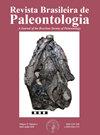伊朗中部马哈拉特地区早始新世沉积物中新的凝集有孔虫:生物地层学和古生态学意义
IF 0.6
4区 地球科学
Q4 PALEONTOLOGY
引用次数: 0
摘要
本文介绍了伊朗中部马哈拉特地区有孔虫的关联,并介绍了三种新的凝集锥形有孔虫物种,以构建生物区带框架。利用底栖有孔虫的地层分布特征,划分了由大到小的3个组合带:轮虫-valvulinids组合带、alveolinids-coskinolinids组合带和nummulticides - discyclinids组合带。这些组合具有标志化石的特征,并定位于内斜坡至近外斜坡沉积环境。其生物地层范围划分为中崔阶至早期鲁特阶。此外,在研究区始新统下浅水灰岩中,首次发现了3种新的球状有孔虫:Daviesiconus mahallatensis sp. nov.、Barattolites arghadehensis sp. nov.和Coleiconus minimus sp. nov.。这些新种具有共同的特征,如早期的偏心锥形试验(相对卷曲的腔室数量较少)和成虫期的单列腔(单列腔),但它们在大小、试验形式和径向表皮下分区(梁、骨间梁和椽子)上有所不同。它们与Alveolina动物群指数相关,其生物地层范围属于早始新世-伊波斯纪中晚期。关键词:生物地层学,早始新世,新分类群,伊朗Mahallat本文章由计算机程序翻译,如有差异,请以英文原文为准。
New agglutinated Foraminifera from Early Eocene deposits of Mahallat region, Central Iran: implication on biostratigraphy and paleoecology
This paper describes the foraminiferal associations along with the presentation of three new agglutinated conical foraminiferal species to the construction of the biozonation framework in the Mahallat region of central Iran. The stratigraphic distribution of benthic foraminifers is used to characterize three assemblage zones that are in ascending order: rotaliids-valvulinids Assemblage Zone, alveolinids-coskinolinids Assemblage Zone, and nummulitids-discocyclinids Assemblage Zone. These associations are characterized by marker fossils and localized from the inner ramp to the proximal outer ramp depositional environments. Their biostratigraphic range is assigned to the middle Cuisian to early Lutetian. In addition, three new agglutinated conical foraminiferal species: Daviesiconus mahallatensis sp. nov., Barattolites arghadehensis sp. nov., and Coleiconus minimus sp. nov. are described and figured for the first time from the lower Eocene shallow-water limestone in the studied area. These new species have common characteristics such as eccentric conical test with a low number of comparably coiled chambers in the early stage and uniserial chambers in the adult stage, but they differ in size, the form of test, and radial subepidermal partitions (beams, intercalary beams, and rafters). They are associated with the index Alveolina fauna and their biostratigraphic range is assigned to middle–late Cuisian (Ypresian, Early Eocene). Keywords: biostratigraphy, Early Eocene, new taxa, Mahallat, Iran.
求助全文
通过发布文献求助,成功后即可免费获取论文全文。
去求助
来源期刊

Revista Brasileira De Paleontologia
PALEONTOLOGY-
CiteScore
1.60
自引率
14.30%
发文量
25
审稿时长
>12 weeks
期刊介绍:
It publishes original contributions on all aspects of Paleontology. Papers are written in English, Spanish, or Portuguese and are reviewed by international experts.
 求助内容:
求助内容: 应助结果提醒方式:
应助结果提醒方式:


